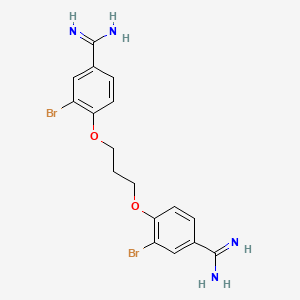
Dibrompropamidine
Número de catálogo B1201361
:
496-00-4
Peso molecular: 470.2 g/mol
Clave InChI: GMJFVGRUYJHMCO-UHFFFAOYSA-N
Atención: Solo para uso de investigación. No para uso humano o veterinario.
Patent
US07947741B2
Procedure details


Efflux pump inhibitory activity of propamidine, dibromopropamidine, and hexamidine was confirmed in Leu-Nap accumulation assays. The uptake of Leu-Nap (100 μg/ml) by PAM1723 (FIGS. 10A, C, and E) or PAM1626 (FIGS. 10B, D, and F) cells was studied in the presence of various concentrations of propamidine (0 μg/ml to 160 μg/ml), dibromopropamidine (0 to μg/ml to 40 μg/ml), and hexamidine (0 μg/ml to 40 μg/ml), respectively. All three compounds were capable of completely inhibiting the MexAB-OprM-mediated efflux of Leu-Nap from the strain overexpressing this pump. The rate of Leu-NAp uptake into PAM1626, and PAM1723, in the presence of 160 μg/ml propamidine, 20 μg/ml of dibromoproapmidine, and 20 μg/ml of hexamidine was the same.



Identifiers


|
REACTION_CXSMILES
|
C1C(C(N)=N)=CC=C(O[CH2:11][CH2:12][CH2:13][O:14][C:15]2[CH:16]=[CH:17][C:18]([C:21]([NH2:23])=[NH:22])=[CH:19][CH:20]=2)C=1.[CH:24]1[C:29]([C:30]([NH2:32])=[NH:31])=[CH:28][C:27](Br)=[C:26]([O:34][CH2:35][CH2:36]COC2C=CC(C(N)=N)=CC=2Br)[CH:25]=1.C1C(C(N)=N)=CC=C(OCCCCCCOC2C=CC(C(N)=N)=CC=2)C=1>N[C@H](C(O)=O)CC(C)C>[CH:28]1[C:29]([C:30]([NH2:32])=[NH:31])=[CH:24][CH:25]=[C:26]([O:34][CH2:35][CH2:36][CH2:11][CH2:12][CH2:13][O:14][C:15]2[CH:20]=[CH:19][C:18]([C:21]([NH2:23])=[NH:22])=[CH:17][CH:16]=2)[CH:27]=1
|
Inputs


Step One
|
Name
|
|
|
Quantity
|
0 (± 1) mol
|
|
Type
|
reactant
|
|
Smiles
|
C1=CC(=CC=C1C(=N)N)OCCCOC=2C=CC(=CC2)C(=N)N
|
Step Two
|
Name
|
|
|
Quantity
|
0 (± 1) mol
|
|
Type
|
reactant
|
|
Smiles
|
C1=CC(=C(C=C1C(=N)N)Br)OCCCOC2=C(C=C(C=C2)C(=N)N)Br
|
Step Three
|
Name
|
|
|
Quantity
|
0 (± 1) mol
|
|
Type
|
reactant
|
|
Smiles
|
C1=CC(=CC=C1C(=N)N)OCCCCCCOC=2C=CC(=CC2)C(=N)N
|
Step Four
|
Name
|
|
|
Quantity
|
0 (± 1) mol
|
|
Type
|
solvent
|
|
Smiles
|
N[C@@H](CC(C)C)C(=O)O
|
Conditions


Other
|
Conditions are dynamic
|
1
|
|
Details
|
See reaction.notes.procedure_details.
|
Workups


CONCENTRATION
|
Type
|
CONCENTRATION
|
|
Details
|
The uptake of Leu-Nap (100 μg/ml) by PAM1723 (FIGS. 10A, C, and E) or PAM1626 (FIGS. 10B, D, and F) cells was studied in the presence of various concentrations of propamidine (0 μg/ml to 160 μg/ml), dibromopropamidine (0 to μg/ml to 40 μg/ml), and hexamidine (0 μg/ml to 40 μg/ml)
|
Outcomes


Product
|
Name
|
|
|
Type
|
|
|
Smiles
|
C1=CC(=CC=C1C(=N)N)OCCCCCOC=2C=CC(=CC2)C(=N)N
|
Source


|
Source
|
Open Reaction Database (ORD) |
|
Description
|
The Open Reaction Database (ORD) is an open-access schema and infrastructure for structuring and sharing organic reaction data, including a centralized data repository. The ORD schema supports conventional and emerging technologies, from benchtop reactions to automated high-throughput experiments and flow chemistry. Our vision is that a consistent data representation and infrastructure to support data sharing will enable downstream applications that will greatly improve the state of the art with respect to computer-aided synthesis planning, reaction prediction, and other predictive chemistry tasks. |
Patent
US07947741B2
Procedure details


Efflux pump inhibitory activity of propamidine, dibromopropamidine, and hexamidine was confirmed in Leu-Nap accumulation assays. The uptake of Leu-Nap (100 μg/ml) by PAM1723 (FIGS. 10A, C, and E) or PAM1626 (FIGS. 10B, D, and F) cells was studied in the presence of various concentrations of propamidine (0 μg/ml to 160 μg/ml), dibromopropamidine (0 to μg/ml to 40 μg/ml), and hexamidine (0 μg/ml to 40 μg/ml), respectively. All three compounds were capable of completely inhibiting the MexAB-OprM-mediated efflux of Leu-Nap from the strain overexpressing this pump. The rate of Leu-NAp uptake into PAM1626, and PAM1723, in the presence of 160 μg/ml propamidine, 20 μg/ml of dibromoproapmidine, and 20 μg/ml of hexamidine was the same.



Identifiers


|
REACTION_CXSMILES
|
C1C(C(N)=N)=CC=C(O[CH2:11][CH2:12][CH2:13][O:14][C:15]2[CH:16]=[CH:17][C:18]([C:21]([NH2:23])=[NH:22])=[CH:19][CH:20]=2)C=1.[CH:24]1[C:29]([C:30]([NH2:32])=[NH:31])=[CH:28][C:27](Br)=[C:26]([O:34][CH2:35][CH2:36]COC2C=CC(C(N)=N)=CC=2Br)[CH:25]=1.C1C(C(N)=N)=CC=C(OCCCCCCOC2C=CC(C(N)=N)=CC=2)C=1>N[C@H](C(O)=O)CC(C)C>[CH:28]1[C:29]([C:30]([NH2:32])=[NH:31])=[CH:24][CH:25]=[C:26]([O:34][CH2:35][CH2:36][CH2:11][CH2:12][CH2:13][O:14][C:15]2[CH:20]=[CH:19][C:18]([C:21]([NH2:23])=[NH:22])=[CH:17][CH:16]=2)[CH:27]=1
|
Inputs


Step One
|
Name
|
|
|
Quantity
|
0 (± 1) mol
|
|
Type
|
reactant
|
|
Smiles
|
C1=CC(=CC=C1C(=N)N)OCCCOC=2C=CC(=CC2)C(=N)N
|
Step Two
|
Name
|
|
|
Quantity
|
0 (± 1) mol
|
|
Type
|
reactant
|
|
Smiles
|
C1=CC(=C(C=C1C(=N)N)Br)OCCCOC2=C(C=C(C=C2)C(=N)N)Br
|
Step Three
|
Name
|
|
|
Quantity
|
0 (± 1) mol
|
|
Type
|
reactant
|
|
Smiles
|
C1=CC(=CC=C1C(=N)N)OCCCCCCOC=2C=CC(=CC2)C(=N)N
|
Step Four
|
Name
|
|
|
Quantity
|
0 (± 1) mol
|
|
Type
|
solvent
|
|
Smiles
|
N[C@@H](CC(C)C)C(=O)O
|
Conditions


Other
|
Conditions are dynamic
|
1
|
|
Details
|
See reaction.notes.procedure_details.
|
Workups


CONCENTRATION
|
Type
|
CONCENTRATION
|
|
Details
|
The uptake of Leu-Nap (100 μg/ml) by PAM1723 (FIGS. 10A, C, and E) or PAM1626 (FIGS. 10B, D, and F) cells was studied in the presence of various concentrations of propamidine (0 μg/ml to 160 μg/ml), dibromopropamidine (0 to μg/ml to 40 μg/ml), and hexamidine (0 μg/ml to 40 μg/ml)
|
Outcomes


Product
|
Name
|
|
|
Type
|
|
|
Smiles
|
C1=CC(=CC=C1C(=N)N)OCCCCCOC=2C=CC(=CC2)C(=N)N
|
Source


|
Source
|
Open Reaction Database (ORD) |
|
Description
|
The Open Reaction Database (ORD) is an open-access schema and infrastructure for structuring and sharing organic reaction data, including a centralized data repository. The ORD schema supports conventional and emerging technologies, from benchtop reactions to automated high-throughput experiments and flow chemistry. Our vision is that a consistent data representation and infrastructure to support data sharing will enable downstream applications that will greatly improve the state of the art with respect to computer-aided synthesis planning, reaction prediction, and other predictive chemistry tasks. |

